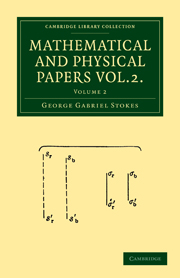Book contents
- Frontmatter
- Contents
- Notes on Hydrodynamics. III. On the Dynamical Equations
- On the constitution of the Luminiferous Ether
- On the Theory of certain Bands seen in the Spectrum
- Notes on Hydrodynamics. IV. Demonstration of a Fundamental Theorem
- On a difficulty in the Theory of Sound
- On the Formation of the Central Spot of Newton's Rings beyond the Critical Angle
- On some points in the Received Theory of Sound
- On the perfect Blackness of the Central Spot in Newton's Rings, and on the Verification of Fresnel's Formula for the intensities of Reflected and Reflacted Rays
- On Attractions, and on Clairaut's Theorem
- On the Variation of Gravity at the Surface of the Earth
- On a Mode of Measuring the Astigmatism of a Defective Eye
- On the Determination of the Wave Length corresponding with any Point of the Spectrum
- Discussion of a Differential Equation relating to the Breaking of Railway Bridges
- Notes on Hydrodynamics, VI. On Waves
- On the Dynamical Theory of Diffraction
- On the Numerical Calculation of a class of Definite Integrals and Infinite Series
- On the Mode of Disappearance of Newton's Rings in passing the Angle of Total Internal Reflection
- On Metallic Reflection
- On a Fictitious Displacement of Fringes of Interference
- On Haidinger's Brushes
- Index
On the Variation of Gravity at the Surface of the Earth
Published online by Cambridge University Press: 07 September 2010
- Frontmatter
- Contents
- Notes on Hydrodynamics. III. On the Dynamical Equations
- On the constitution of the Luminiferous Ether
- On the Theory of certain Bands seen in the Spectrum
- Notes on Hydrodynamics. IV. Demonstration of a Fundamental Theorem
- On a difficulty in the Theory of Sound
- On the Formation of the Central Spot of Newton's Rings beyond the Critical Angle
- On some points in the Received Theory of Sound
- On the perfect Blackness of the Central Spot in Newton's Rings, and on the Verification of Fresnel's Formula for the intensities of Reflected and Reflacted Rays
- On Attractions, and on Clairaut's Theorem
- On the Variation of Gravity at the Surface of the Earth
- On a Mode of Measuring the Astigmatism of a Defective Eye
- On the Determination of the Wave Length corresponding with any Point of the Spectrum
- Discussion of a Differential Equation relating to the Breaking of Railway Bridges
- Notes on Hydrodynamics, VI. On Waves
- On the Dynamical Theory of Diffraction
- On the Numerical Calculation of a class of Definite Integrals and Infinite Series
- On the Mode of Disappearance of Newton's Rings in passing the Angle of Total Internal Reflection
- On Metallic Reflection
- On a Fictitious Displacement of Fringes of Interference
- On Haidinger's Brushes
- Index
Summary
On adopting the hypothesis of the earth's original fluidity, it has been shewn that the surface ought to be perpendicular to the direction of gravity, that it ought to be of the form of an oblate spheroid of small ellipticity, having its axis of figure coincident with the axis of rotation, and that gravity ought to vary along the surface according to a simple law, leading to the numerical relation between the ellipticity and the ratio between polar and equatorial gravity which is known by the name of Clairaut's Theorem. Without assuming the earth's original fluidity, but merely supposing that it consists of nearly spherical strata of equal density, and observing that its surface may be regarded as covered by a fluid, inasmuch as all observations relating to the earth's figure are reduced to the level of the sea, Laplace has established a connexion between the form of the surface and the variation of gravity, which in the particular case of an oblate spheroid agrees with the connexion which is found on the hypothesis of original fluidity. The object of the first portion of this paper is to establish this general connexion without making any hypothesis whatsoever respecting the distribution of matter in the interior of the earth, but merely assuming the theory of universal gravitation.
- Type
- Chapter
- Information
- Mathematical and Physical Papers , pp. 131 - 171Publisher: Cambridge University PressPrint publication year: 2009First published in: 1883
- 5
- Cited by

